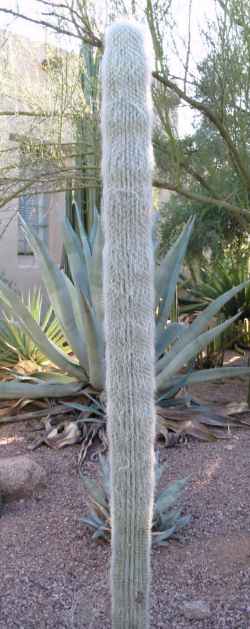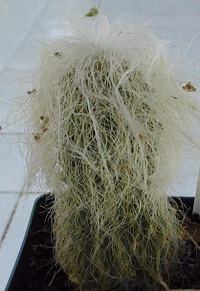Old Man Cactus, Old Man of Mexico, Cabeza de Viejo
Scientific Name: Cephalocereus senilis (Haw.) Pfeiff.
Synonym: Cactus bradypus, Cactus senilis, Cephalophorus senilis, Cereus senilis, Echinocactus staplesiae, Pilocereus senilis
Family: Cactaceae
Sunset®: 11-13,21-24
USDA: 9-10
Frost Tolerance: Hardy to 14°F (-10°C) for short periods
Heat Tolerance: Prefers some afternoon shade in the low deserts
Sun Exposure: Full sun
Origin: Mexico (Hidalgo, Guanajuato)
Growth Habits: Slow growing to a large column, seldom ramified, 45 feet tall (11 m) by 18 inches (45 cm) in diameter; 12 to 30 ribs; 1 to 5 central spines, up to 2 inches long (5 cm); 20 to 30 hair-like laterals.
Watering Needs: Little to moderate water in summer, almost none in winter, very rot prone particularly when young, needs good drainage
Propagation: Seeds, cuttings

Cephalocereus senilis at the DBG
Most of the species from the Cephalocereus genus have been moved to Pilosocereus.
Blooming Habits:
The pseudocephalium starts on the side of the stems when they reach 20 feet (6 m). The woolly hair can reach 8 inches or more (20 cm). Eventually the pseudocephalium will cover the top of the stem.
The 2-inch long whitish pink flowers (5 cm), open at night in April. They are followed by pinkish-red fruit, 0.8 to 1.2 inches long (2-3 cm) covered with yellowish hair.
Culture:
In nature, the Cephalocereus reaches 2 feet tall in 20 years, it can be much faster with proper watering and fertilizing. To keep the cactus smaller, the top can be cut in spring, dried for 3 days, and replanted. It is possible to wash the white "hair" with diluted shampoo to keep it white.
Desert-Tropicals is dedicated to provide gardening advice, gardening ideas, and information about flower of all kind for landscape and collections.We try to check carefully the identification of the plants on the illustrations as well as the other information from the page, but occasionally errors do occur. if you notice anything that needs to be changed please contact us.Thanks.
© 1998-2020 Philippe Faucon, All Rights Reserved.
